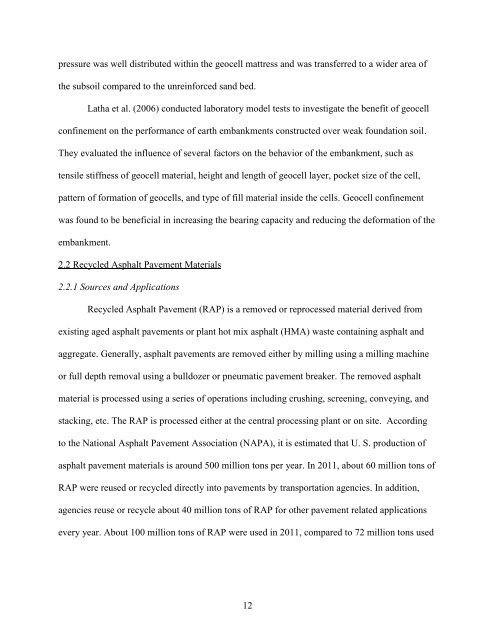Onsite Use of Recycled Asphalt Pavement Materials and Geocells to ...
Onsite Use of Recycled Asphalt Pavement Materials and Geocells to ...
Onsite Use of Recycled Asphalt Pavement Materials and Geocells to ...
Create successful ePaper yourself
Turn your PDF publications into a flip-book with our unique Google optimized e-Paper software.
pressure was well distributed within the geocell mattress <strong>and</strong> was transferred <strong>to</strong> a wider area <strong>of</strong><br />
the subsoil compared <strong>to</strong> the unreinforced s<strong>and</strong> bed.<br />
Latha et al. (2006) conducted labora<strong>to</strong>ry model tests <strong>to</strong> investigate the benefit <strong>of</strong> geocell<br />
confinement on the performance <strong>of</strong> earth embankments constructed over weak foundation soil.<br />
They evaluated the influence <strong>of</strong> several fac<strong>to</strong>rs on the behavior <strong>of</strong> the embankment, such as<br />
tensile stiffness <strong>of</strong> geocell material, height <strong>and</strong> length <strong>of</strong> geocell layer, pocket size <strong>of</strong> the cell,<br />
pattern <strong>of</strong> formation <strong>of</strong> geocells, <strong>and</strong> type <strong>of</strong> fill material inside the cells. Geocell confinement<br />
was found <strong>to</strong> be beneficial in increasing the bearing capacity <strong>and</strong> reducing the deformation <strong>of</strong> the<br />
embankment.<br />
2.2 <strong>Recycled</strong> <strong>Asphalt</strong> <strong>Pavement</strong> <strong>Materials</strong><br />
2.2.1 Sources <strong>and</strong> Applications<br />
<strong>Recycled</strong> <strong>Asphalt</strong> <strong>Pavement</strong> (RAP) is a removed or reprocessed material derived from<br />
existing aged asphalt pavements or plant hot mix asphalt (HMA) waste containing asphalt <strong>and</strong><br />
aggregate. Generally, asphalt pavements are removed either by milling using a milling machine<br />
or full depth removal using a bulldozer or pneumatic pavement breaker. The removed asphalt<br />
material is processed using a series <strong>of</strong> operations including crushing, screening, conveying, <strong>and</strong><br />
stacking, etc. The RAP is processed either at the central processing plant or on site. According<br />
<strong>to</strong> the National <strong>Asphalt</strong> <strong>Pavement</strong> Association (NAPA), it is estimated that U. S. production <strong>of</strong><br />
asphalt pavement materials is around 500 million <strong>to</strong>ns per year. In 2011, about 60 million <strong>to</strong>ns <strong>of</strong><br />
RAP were reused or recycled directly in<strong>to</strong> pavements by transportation agencies. In addition,<br />
agencies reuse or recycle about 40 million <strong>to</strong>ns <strong>of</strong> RAP for other pavement related applications<br />
every year. About 100 million <strong>to</strong>ns <strong>of</strong> RAP were used in 2011, compared <strong>to</strong> 72 million <strong>to</strong>ns used<br />
12
















